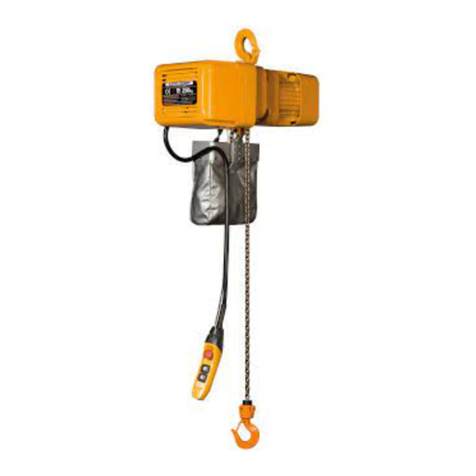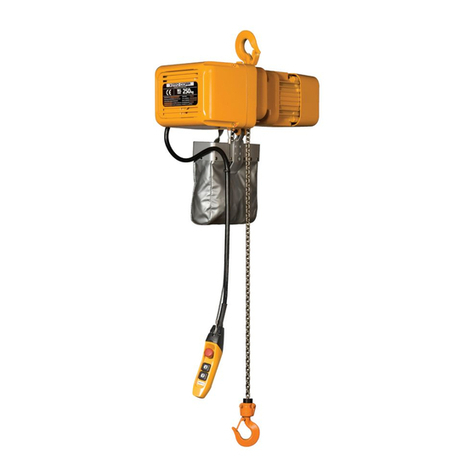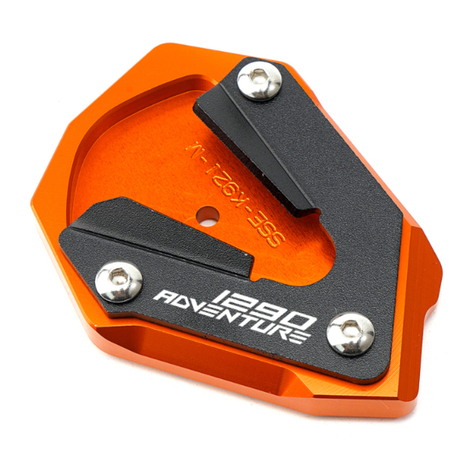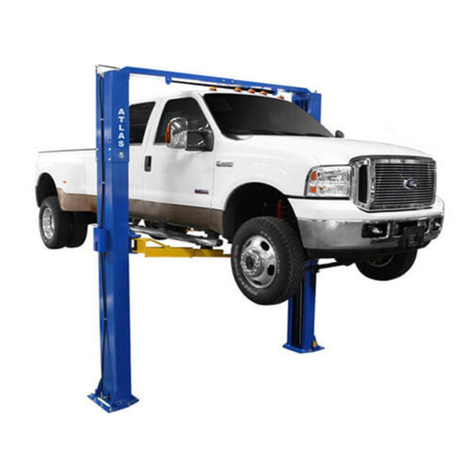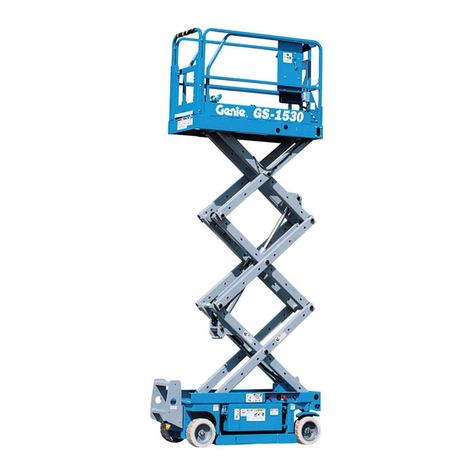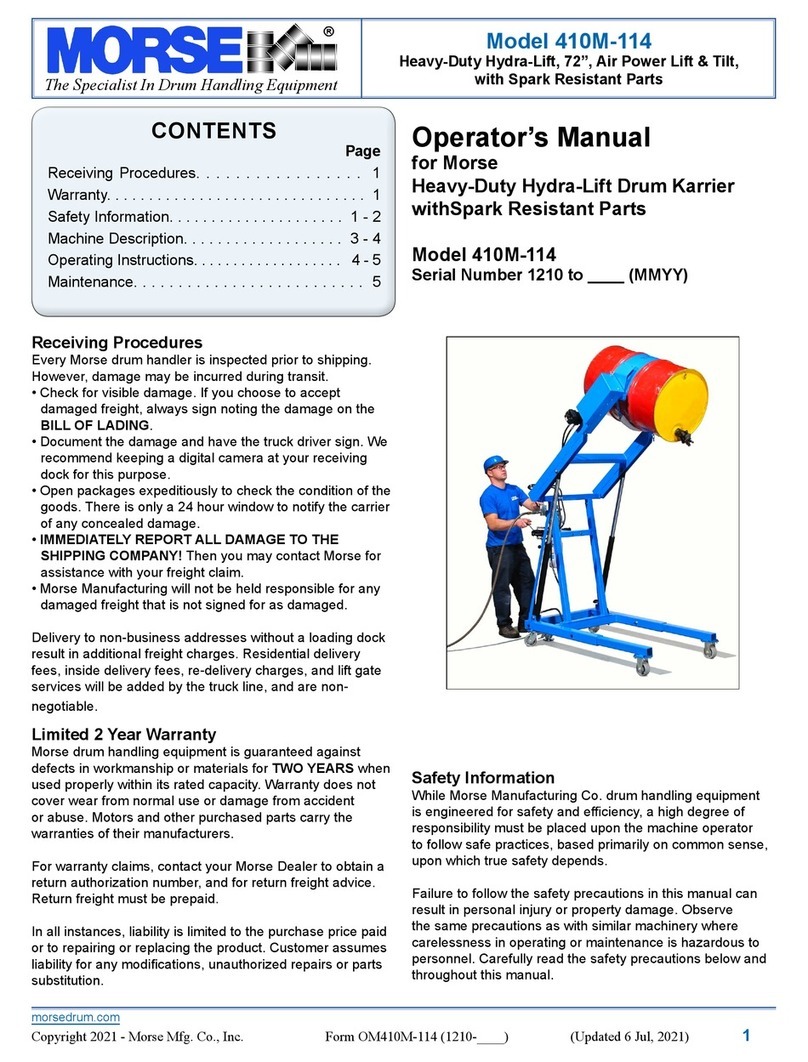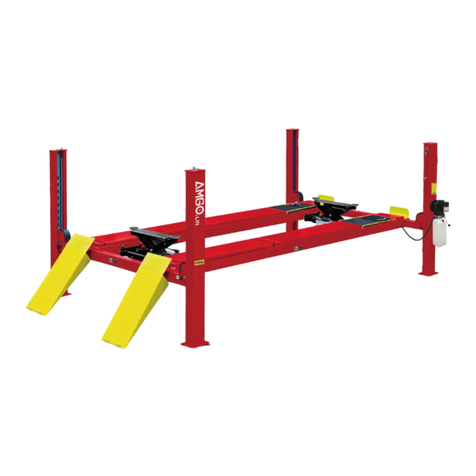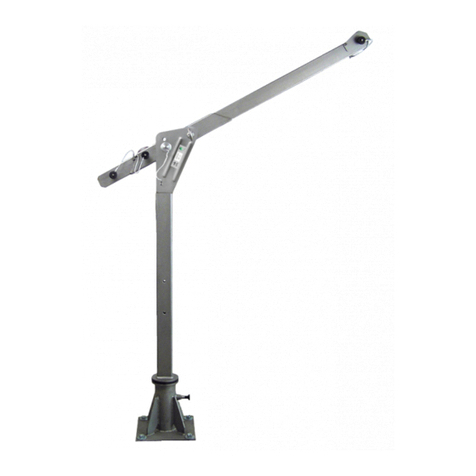KITO RY Series Operation instructions

URL. http://www.kito.com
RY Series Wire Rope Hoist (2.8t to 5t) Disassembly and Reassembly Manual
RY
Series Wire Rope Hoist (2.8t to 5t)
Disassembly and Reassembly Manual
Low Headroom Type: RYL
AS-RYLZZZ-MGE-01
Persons performing disassembly/reassembly
Disassembly/reassembly shall be performed by a competent person (a person duly authorized by the company as having expertise on the structure
and device of the Wire rope hoist) or consult KITO.
This Disassembly and Reassembly Manual includes contents to prevent injury to any person performing
Disassembly and reassembly, users, and other persons and damage to property, and to disassemble/
reassemble the Wire rope hoist safely and correctly.Before performing disassembly/reassembly, be sure to
read and follow this manual as well as the RY series Wire Rope Hoist Owner's Manual (separate document)
since its contents are also important for Disassembly/reassembly.Disassembly/reassembly of the Wire rope
hoist are required operations for regular inspection and repair.Carry out disassembly/reassembly properly in
accordance with these manuals.
Safety precaution

1352
Safety Precautions
Improper use of the hoist may cause serious accidents resulting in death or severe injury such as drop
of lifted load. Read this Disassembly and Reassembly Manual carefully before installation, operation
and maintenance. Use the product after understanding the product knowledge, safety information and
precautions.This Disassembly and Reassembly Manual classies the safety information and precautions
into three categories of“DANGER”,“WARNING”, and “CAUTION”. Also read the instruction manual of the
device associated with the hoist (option, crane, etc.), and follow the described contents.
Description of Safety Symbols
means “Prohibited” or “You must not do”.
Prohibited action is shown in the circle or described near the circle with words and figures.
This Disassembly and Reassembly Manual uses as the general prohibition.
means “Mandatory Action” or “You must do”.
Required action is shown in the circle or described near the circle with words and figures.
This Disassembly and Reassembly Manual uses as the general instruction.
Further, the event described in CAUTION may result in serious accident depending on the situation. All of
these items describe important matters. Please follow the instruction.After reading, please keep this manual
at hand for future use by the user.
Indicates an imminently hazardous situation which, if not avoided, will result in
death or severe injury.
Description of Signal Words
DANGER
WARNING
CAUTION
Indicates a potentially hazardous situation which, if not avoided, could result in
death or severe injury.
Indicates a potentially hazardous situation which, if not avoided, may result in
minor or moderate injury. It may also be used to alert against unsafe practices.
Prohibited
Mandatory
Safety Precautions

3
■Disassembly and reassembly (general)
Safety precaution Disassembly and reassembly (general)
Prohibited
Mandatory
• Do not use oil such as gear grease and lubricating oil in areas near a fire or spark.
Failure to follow this instruction may result in fire or severe injury arising from ignition.
• Carry out the installation or removal work of the rope hoist after securing the stable foothold.
Failure to follow this instruction may result in death or severe injury due to falling or dropping.
• Carry out the installation or removal work of the rope hoist after shutting down the power distribution panel.
Failure to follow this instruction may result in death or severe injury due to an electric shock.
• When reassembly is complete, perform a function check (preoperational check) to make sure it operates properly.
Failure to follow this instruction may result in death or severe injury.
For details, refer to 'Periodic Inspection' in the separated Owner's Manual.
• Tighten the bolts and nuts with the specified tightening torques.
Failure to follow this instruction may result in death or severe injury.
• Only competent persons must disassemble/reassemble the rope hoist.
Disassembly/reassembly by anyone other than competent persons may result in death or sever injury.
• Do not use unauthorized parts for RY Series Wire Rope Hoist.
Even if the part is an authorized part, it may not be used for a different model.
Use parts correctly in accordance with this manual.
Failure to follow this instruction may result in death or severe injury.
• Do not perform disassembly/reassembly during conduction.
Failure to follow this instruction may result in death or severe injury due to an electric shock or unexpected operation.
• Do not disassemble/reassemble the rope hoist while it is being suspended.
When disassembling/reassembling the rope hoist, place it on the floor and perform them on the workbench.
Failure to follow this instruction may result in death or severe injury.
DANGER
Prohibited
Prohibited
Prohibited
Mandatory
Mandatory
Mandatory
Prohibited

4
Safety precautionBefore disassembly and reassembly
■Before disassembly and reassembly
CAUTION
The disassembly and reassembly procedures are described based on the representative model. Note that components may be slightly
different for different capacities. In addition, the specifications may be changed without prior notice and may be different from the actual
products.
• Disassembling/reassembling improperly causes death or severe injury. Only competent persons with expertise and
experience must disassemble/reassemble the rope hoist.
Alternatively, contact the nearest distributor or KITO.
(Refer to the back of this manual.)
• Perform disassembly and reassembly in correct procedures as described in the manual.
• Before reassembling the parts such as gear, clean and remove oil and dust on them.
Especially when a plastic hammer is used, clean them thoroughly so that no chip of the hammer remains inside.
• Prepare anti-loosening (screw lock) for bolts. Apply it to the specified locations.
• Use only authorized parts for replacement.
Failure to follow these instructions may result in death or severe injury.
• When reassembling, follow the instructions below.
• Before reassembly, remove dust and oil on the part to be reused.
• Insert snap rings completely in the groove.
• When closing the control box cover, be careful so that your finger won't get caught.
• Assemble the wire rope without torsion.
Failure to follow these instructions may cause loss of property arising from damaged product or dropped parts.
• When reassembling, replace the following parts with new ones.
• Gear grease (Type and required amount of grease vary depending on the specification and main body size. Refer to
the separated "RY Series Wire Rope Hoist Owner's Manual".
• Packing and the like
• Molybdenum disulfide lubricant, Molytherm No.2 (specified brand, manufactured by SUMICO LUBRICANT)
• Oil seal
• Snap ring
• Split pin
• O-ring
• Spring pin
Failure to follow this instruction may cause bodily injury or loss of property.
NOTE
DANGER
Mandatory
Mandatory
Mandatory

5
Table of Contents
Table of Contents
Table of Contents ...........................................................................5
Disassembly and assembly tool ...................................................6
Major parts in common..................................................................7
Name of parts..................................................................................8
Disassembly procedure.................................................................9
1. Wire rope......................................................................................9
2. Hook block..................................................................................13
3. Anchorage ..................................................................................16
4. Idle sheave .................................................................................18
5. Lifting motor................................................................................19
6. Rope drum..................................................................................28
7. Direct limit switch .......................................................................37
8. Control box .................................................................................40
9. Traversing motor ........................................................................47
10. Trolley frame ..............................................................................55
Reassembly Procedures..............................................................66
Trolley frame ....................................................................................66
Traversing Motor ..............................................................................83
Control Box ......................................................................................91
Direct Limit Switch............................................................................98
Rope Drum Unit .............................................................................103
Lifting Motor ................................................................................... 115
Idle Sheave ....................................................................................124
Anchorage......................................................................................125
Hook Block .....................................................................................127
Wire rope........................................................................................130
Safety Precautions .........................................................................2

6
Disassembly and assembly tool
Disassembly and assembly tool
For disassembly and reassembly, prepare the following tools.
No. Tool/jig name Application Icon
1
Wrench
7 mm/8 mm/13 mm/16 mm/18 mm/
19 mm/22 mm/24 mm/30 mm
Bolts and nuts
2Hexagon wrench
3mm/5mm/6mm/8mm/10mm/14mm Socket bolts
3 Snap ring pliers S Snap rings (shaft)
4 Snap ring pliers R Snap rings (hole)
5
Socket wrench
7 mm/8 mm/13 mm/16 mm/18 mm/
19 mm/22 mm/24 mm/30 mm
Bolts and nuts
6 Combination pliers Split pins
7 Plastic hammer Removing pinions
8 Screwdrivers (+)(-) Screws
9 Puller Ball bearings
10 Thickness gauge Checking brake gaps
11 Torque wrench Setting torque Torque
12 Pliers/Needle nose pliers Set pins
13 Nippers Cutting INSULOK
14 Brush Applying lubricating oil
15 Vise Disassembling lifting motor
16 Wood block Used as a sleeper
17 Fiber sling Used when lifting rope drum and the
like
18 Chain sling Supporting control box unit and the
like
19 Eye type Bolt M12 Supporting control box unit and the
like
20 Round bar Pinions
21 Pin punch Spring pins
22 Spatula Used when removing lubricating oil
●Use the following types of grease.
- Molybdenum disulfide lubricant, Molytherm No.2 (specified brand, manufactured by SUMICO LUBRICANT)
- EPNOC-AP(N)-2 (specified brand, manufactured by JXTG Nippon Oil & Energy Corporation)
- EPNOC-AP(N)-0: 2.5 kg (specified brand, manufactured by JXTG Nippon Oil & Energy Corporation)
- Moly PS Grease No.2
●Helpful tools
- Remover. Preparing remover for bearings (for inner race & outer race) or for oil seal allows easy operation.
- Preparing wire for guiding lead wires will be helpful.

7
Major parts in common
Major parts in common
Rated load 2.8 t/3 t/3.2 t
Rail width (mm) 125-175 176-350 351-500 Dierence
Lifting range (m) 6 7.6 9 10.2 12 6 7.6 9 10.2 12 6 7.6 9 10.2 12
Frame A, B, C, and D a
Suspension shaft a b c Length
Adjusting bolt a b c Length
Drive shaft a b c Length
Drum a d b e c a d b e c a d b e c Length and
diameter
Support shaft a b c a b c a b c Length
Limit switch bolt a b c a b c a b c Length
Drum cover a b c a b c a b c Length
Counter weight a b c a b c a b c Length
Beam a b c a b c a b c Length
Traversing motor a
Hook block a (Rated load
marking)
Wire rope a d b e c a d b e c a d b e c
Structure,
diameter or
length
Rated load 4.8 t/5 t
Rail width (mm) 125-175 176-350 351-500 Dierence
Lifting range (m) 6 7.6 9 10.2 12 6 7.6 9 10.2 12 6 7.6 9 10.2 12
Frame A, B, C, and D b
Suspension shaft d e f Length
Adjusting bolt a b c Length
Drive shaft a b c Length
Drum a d b e c a d b e c a d b e c Length and
diameter
Support shaft a b c a b c a b c Length
Limit switch bolt a b c a b c a b c Length
Drum cover a b c a b c a b c Length
Counter weight d e f d e f d e f Length
Beam a b c a b c a b c Length
Traversing motor b
Hook block b (Rated load
marking)
Wire rope f d g e h f d g e h f d g e h
Structure,
diameter or
length
Rated load
2.8 t/3 t/3.2
t 4.8t/5t Dierence
Lifting speed Standard High Standard High
Gear box a b a c Speed ratio
Lifting motor a b b c Motor capacity
Control box a b b c Inverter
Lifting resistor a b b c Capacity
The table below indicates the major parts in common when the destination and power source are the same.

8
Name of parts
Name of parts
Upper lower
Limit switch
Rope drum
Gear box
Motor (for lifting)
Anchorage
Hook latch
Hook
Wire rope
Idle sheave
Direct limit switch
(Option)
Guide roller
Rope guide
Control box
Wheel
Suspension shaft
Motor
(for traversing)
Adjust bolt
Counter weight
Frame B
Frame A
Frame D
Frame C

9
Wire ropeDisassembly procedure
Disassembly procedure
• Do not disassemble the rope hoist while it is being suspended.
Doing so may result in death or severe injury due to a falling part.
Place it on the floor and perform maintenance on the workbench.
Prohibited
DANGER
The overall disassembly procedure is shown below. Perform disassembly of only necessary parts.
Snap ring
Wire rope
1
■Removing Wire Rope
(1) Remove the snap ring from the hanger support shaft
supporting the Rope End Fixing Part of the Main Unit.
(2) Pull out the hanger support shaft from inside.
(3) Remove the socket.
(4) Remove the hex nuts (two locations), and then the
Wire Clip at the rope end.
Your hands may be injured.
Wear gloves and the like. Be careful of
ne splits of element wires at the rope
end while working.
Mandatory
CAUTION
(5) Tap lightly the tip of the cotter, and pull out the cotter
from the socket.
Hanger support
shaft
Hanger support
shaft
Socket
Hex nuts
Wire clip
Cotter
Plastic hammer
Slotted screw driver

10
Wire rope Disassembly procedure
If it is difficult to tap the tip of the cotter, put a slotted
screw driver on the cotter as shown in the figure and
tap the driver with a hammer.
(6) Remove the Wire Rope from the socket.
(7) Pull out slowly the Wire Rope from the Hook Sheave of
the Hook Block.
(8) Pull out slowly the Wire Rope from the Idle Sheave.
(9) Pull out slowly the Wire Rope from the other Hook
Sheave of the Hook Block.
Socket
Wire Rope
Wire Rope
Hook Sheave
Idle Sheave
Wire Rope

11
Wire ropeDisassembly procedure
There are two types of Rope Guides with different shapes of connecting parts as shown below.
Understand the structures of the Rope Guides first and perform the procedures for each type to remove or
attach parts.
(Type A) (Type B)
Guide B
Guide C
Shim
GuideA
Guide B
Guide C
Guide A
Collar
Structures of Rope Guides
(10) Remove the bolt fixing Guide B, and remove Guide B from Guide
C along the Support Shaft.
Guide C
Guide B
(11) Loosen the socket bolt indicated by the arrow in the figure below. Next, move Guide A toward the Back Frame side until its Guide
Roller does not lie on the wire, and remove the socket bolt you loosened.
Back Frame
side
Reduction
Gear side
Loosen the socket bolt
(Type A) (Type B)
Reduction
Gear side
Back Frame
side
Loosen the socket bolt
Guide Roller Guide Roller
(12) Remove the Rope Guide from the Rope Drum by following the
procedure described below.
12-1. As shown in the figure on the right, rotate Guide A and
Guide C along the Rope Drum using the Guide Roller as
a guide.
Guide Roller
Rope Drum

12
Wire rope Disassembly procedure
12-2. Loosen the socket bolt connecting Guide A to
Guide C, and remove Guide A from the Rope
Drum at a position where Guide A has no
interference with the Support Shaft.
Support Shaft
Socket Bolt
Guide A
12-3. As shown in the figure on the right, rotate Guide
A and Guide C along the Rope Drum with Guide
A removed from the Rope Drum.
12-4. Remove Guide C from the Rope Drum at a
position where Guide C has no interference with
the Support Shaft.
Guide C
(13) Perform unwinding operation while pulling the Wire Rope by hand
so that the Wire Rope does not float away from the Rope Drum.
Remove in advance the Wire Rope to the position of the Rope
Clamp as shown right.
(Fixed state)
(14) Loosen socket bolts and remove Wire Clamps at three locations
to remove the Wire Rope from the Wire Drum. Remove the Wire
Rope while holding it by hand so as to prevent the Wire Rope
from being removed suddenly by tension of the Wire Rope.
(Fixed state)
Socket bolt

13
Hook blockDisassembly procedure
(1) Pull out the spring pin xing the hook nut and hook.
Spring pin
(2) Remove the hook nut xing the hook.
(3) Remove the thrust bearing from the hook.
Hook
Pin punch
Hook nut
■Removing the hook block
Thrust bearing
Hook block
2
Hook nut
Hook

14
Hook block Disassembly procedure
(4) Remove the hook from the trunnion hole.
Hook
Trunnion hole
(5) Remove the hex nuts and spring lock washers xing
the sheave covers A and B.
Hex nut
Sheave cover A
(6) Remove the sheave cover A.
(7) Remove the snap ring xing the sheave subassembly.
(8) Remove the sheave subassembly from the trunnion
subassembly shaft.
Trunnion subassembly shaft
Sheave subas-
sembly
Snap ring
24mm
Spring lock washer

15
Hook blockDisassembly procedure
(10) Pull out the spring pin from the L bracket.
(11) Remove the parts on the opposite side in the same way.
Follow the steps from (5) to (10).
L bracket
Spring pin
(9) Remove the sheave cover B from the trunnion.
Trunnion
Sheave cover B

16
Anchorage Disassembly procedure
(1) Remove the socket bolts and spring lock washers (two
locations for each) of the key plate xing the shaft of
the anchorage, and remove the key plate.
Shaft
Spring lock washer
Key plate
Socket bolt
Anchorage
(2) Pull out the shaft of the anchorage from the hole of
the beam A, and remove the anchorage.
•
Make sure to support the anchorage by hand to
prevent it from dropping.
Shaft
Beam A
Anchorage
[5mm]
■Removing the anchorage
Anchorage
3

17
AnchorageDisassembly procedure
(1) Remove the snap ring xing the anchorage shaft.
(2) Pull out the anchorage shaft from the anchorage
hanger and socket.
Snap ring
Anchorage hanger Anchorage shaft
Socket
■Disassembling the anchorage
(3) Remove the hex nuts (two locations), and remove the
wire clip at the rope end.
Your hands may be injured.
Wear gloves and the like. Be careful of
ne splits of element wires at the rope
end while working.
Mandatory
CAUTION
Hex nut
Wire clip
(4) Hammer the cotter tip gently, and pull out the cotter
from the socket.
• When you feel dicult to hammer the tip of the cotter, apply
a athead screwdriver to the cotter and then hammer it as
shown in the gure.
(5) Remove the wire rope from the socket.
Cotter
Flathead screwdriver
Plastic hammer
Socket
Wire rope

18
Idle sheave Disassembly procedure
(1) Remove the socket bolts (two locations) of the key
plate xing the sheave support, and remove the key
plate.
Spring lock washer
Sheave support
Key plate
Socket bolt
(2) While supporting the idle sheave by hand to prevent
it from dropping, pull out the sheave support from the
hole of the beam B and frame C, and remove the idle
sheave.
Sheave support
Beam B
Frame C
Idle sheave
[5mm]
■Removing the idle sheave
Idle sheave
4
(1) Remove the socket bolts and spring lock washers (two
locations for each) xing the key plate, and remove
the key plate.
(2) Pull out the sheave shaft, and remove the collar and
sheave.
Socket bolt
Key plate
Sheave hanger
Sheave
Sheave shaft
Collar
Collar
Spring lock
washer
[5mm]
■Disassembling the idle sheave

19
Lifting motorDisassembly procedure
(1) Cut the cable band xing the lifting motor harness to
the joint plate.
(2) Remove the round head screws and spring lock
washers (four locations for each) xing the terminal
packing and terminal cover, and remove the terminal
cover and terminal packing.
Cable band
Lifting motor harness
Joint plate
Spring lock washer
Round head screw
Terminal cover
Terminal packing
Terminal box
■Removing the lifting motor harness (terminal box side)
●For 200V-03S, 03H, 05S, 400V-03S, 03H, 05S, and 05H
Lifting motor
5
(3) Pull out the lead wire contained in the terminal box.
Lead wire
Terminal box

20
Lifting motor Disassembly procedure
(4) Cut the cable band xing the insulation cap, and re-
move the insulation caps (three locations).
•
When removing plastic insulation caps, refer to the procedure
below.
Cable band
Insulation cap
a) While pushing here,
b) remove the cap downwards.
After removal
How to remove
(5) Remove the round head screw, spring lock washer,
and hex nut each connecting the lead wires (red,
white, and black) of the lifting motor harness to the
lead wires (mark tube with U, V, and W) extended
from the lifting motor.
Then loosen the round head screw xing the ground
wire (green/yellow) into the terminal box, and remove
the ground wire.
U
V
W
Round head screw, spring lock washer, and hex nut
Red
White
Black
Ground wire
Round head screw
[7mm/8mm]
(6) Then loosen the round head screw xing the ground
wire (green/yellow) into the terminal box, and remove
the ground wire.
Other manuals for RY Series
1
Table of contents
Other KITO Lifting System manuals
Popular Lifting System manuals by other brands
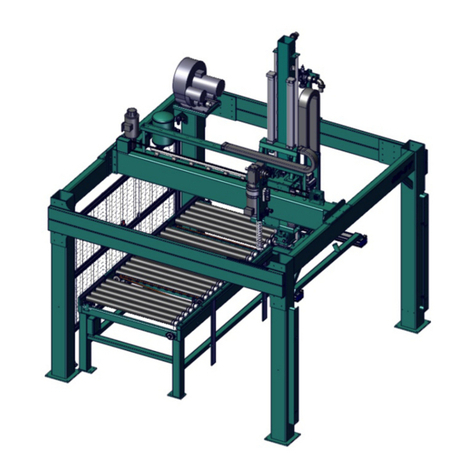
Kval
Kval ON-3V Operation manual

Vestil
Vestil MFM-1300 instruction manual
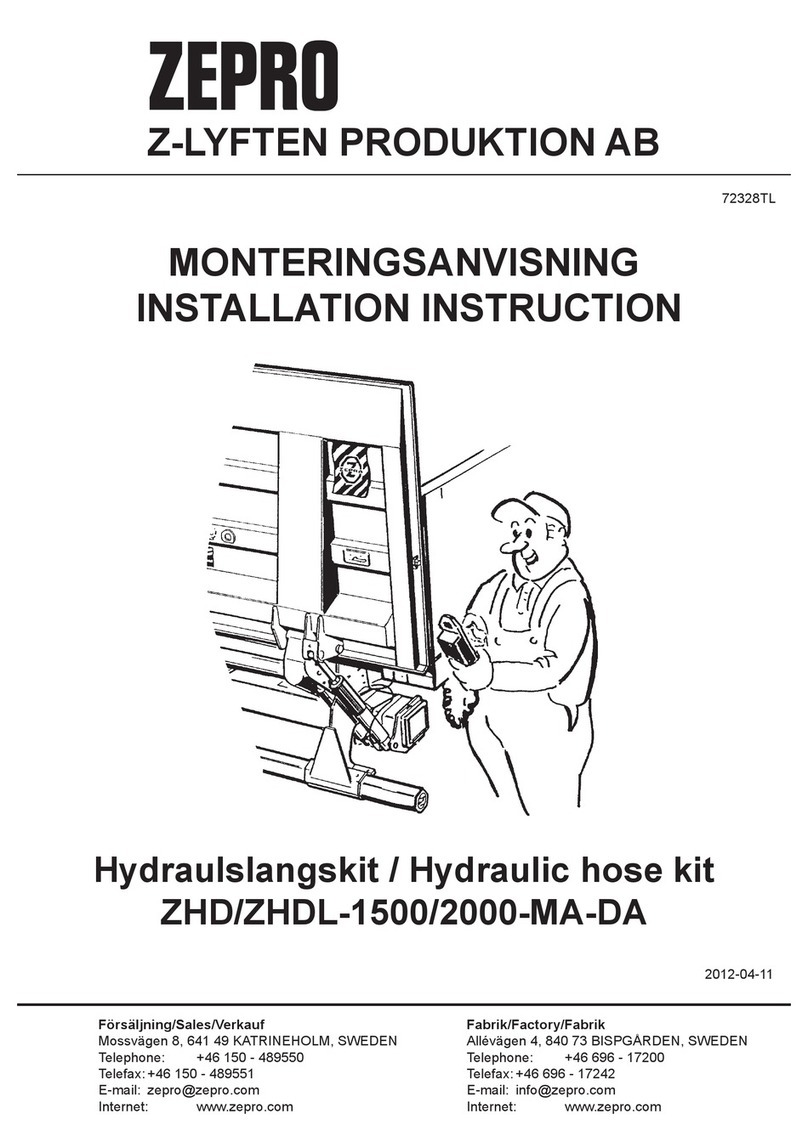
Zepro
Zepro ZHD-1500-MA-DA Installation instruction

Challenger Lifts
Challenger Lifts 24012 E Operation installation maintenance manual
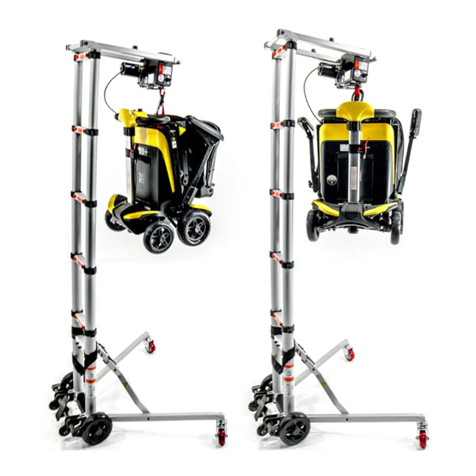
Enhance Mobility
Enhance Mobility Hercules instructions

AMGO
AMGO 408-P Installation and service manual
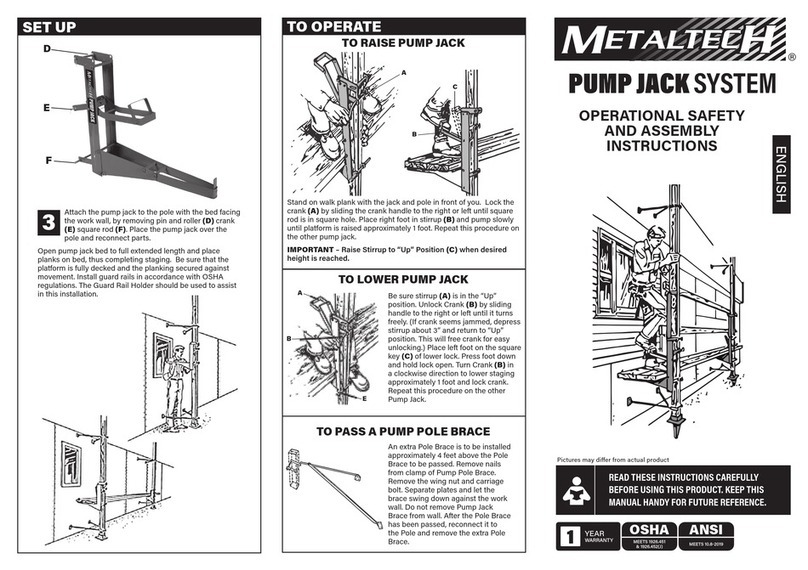
MetalTech
MetalTech PJ-PJST OPERATIONAL SAFETY AND ASSEMBLY INSTRUCTIONS

Vestil
Vestil FRA-4-238 quick start guide
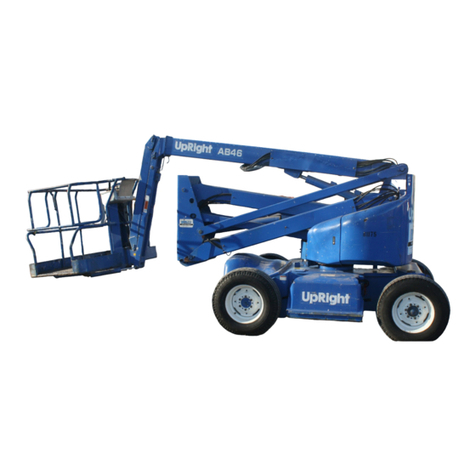
Upright
Upright AB-46 Bi-Energy Operator's manual
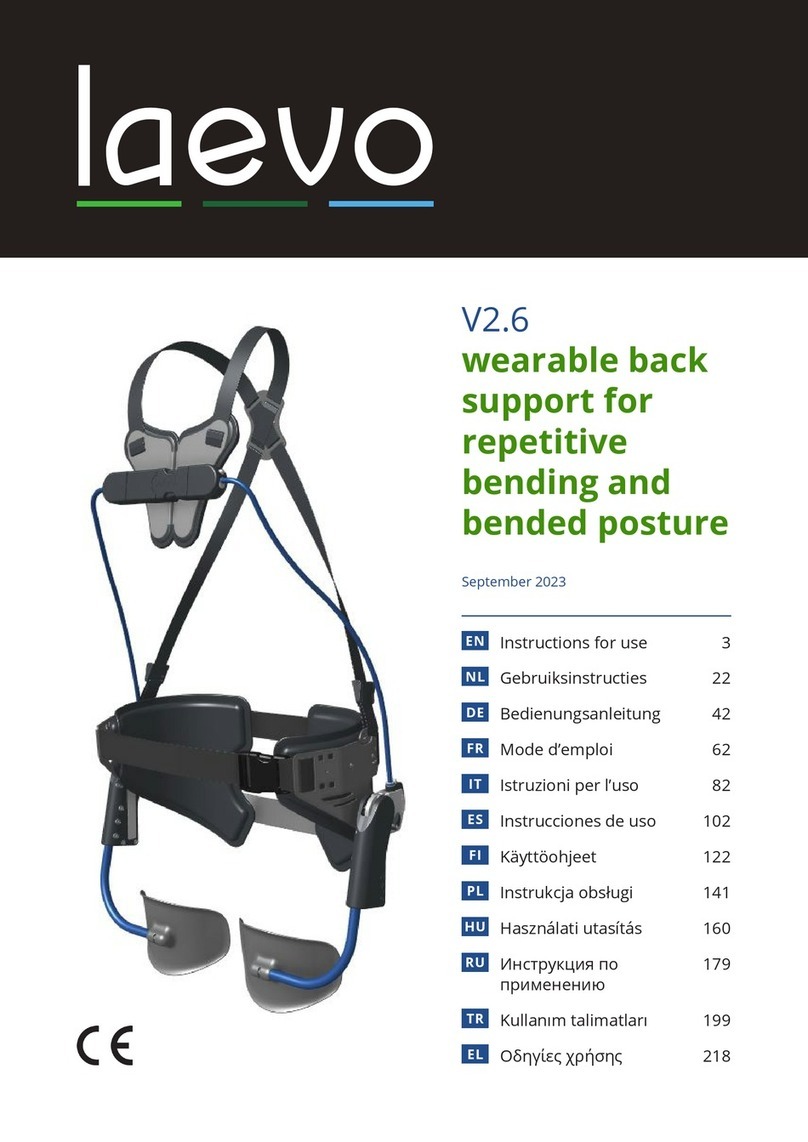
Laevo
Laevo V2.6 Instructions for use
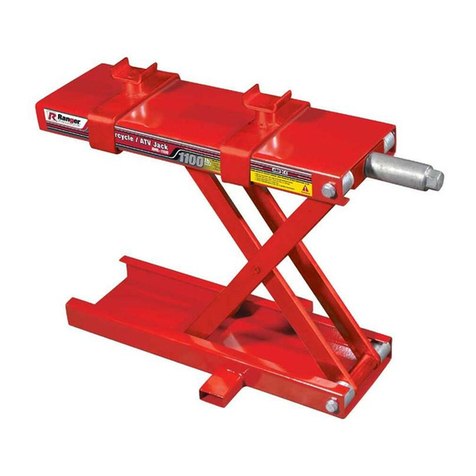
Ranger Products
Ranger Products RML-1100 Installation and operation manual

SVERO
SVERO 6411 User instructions
